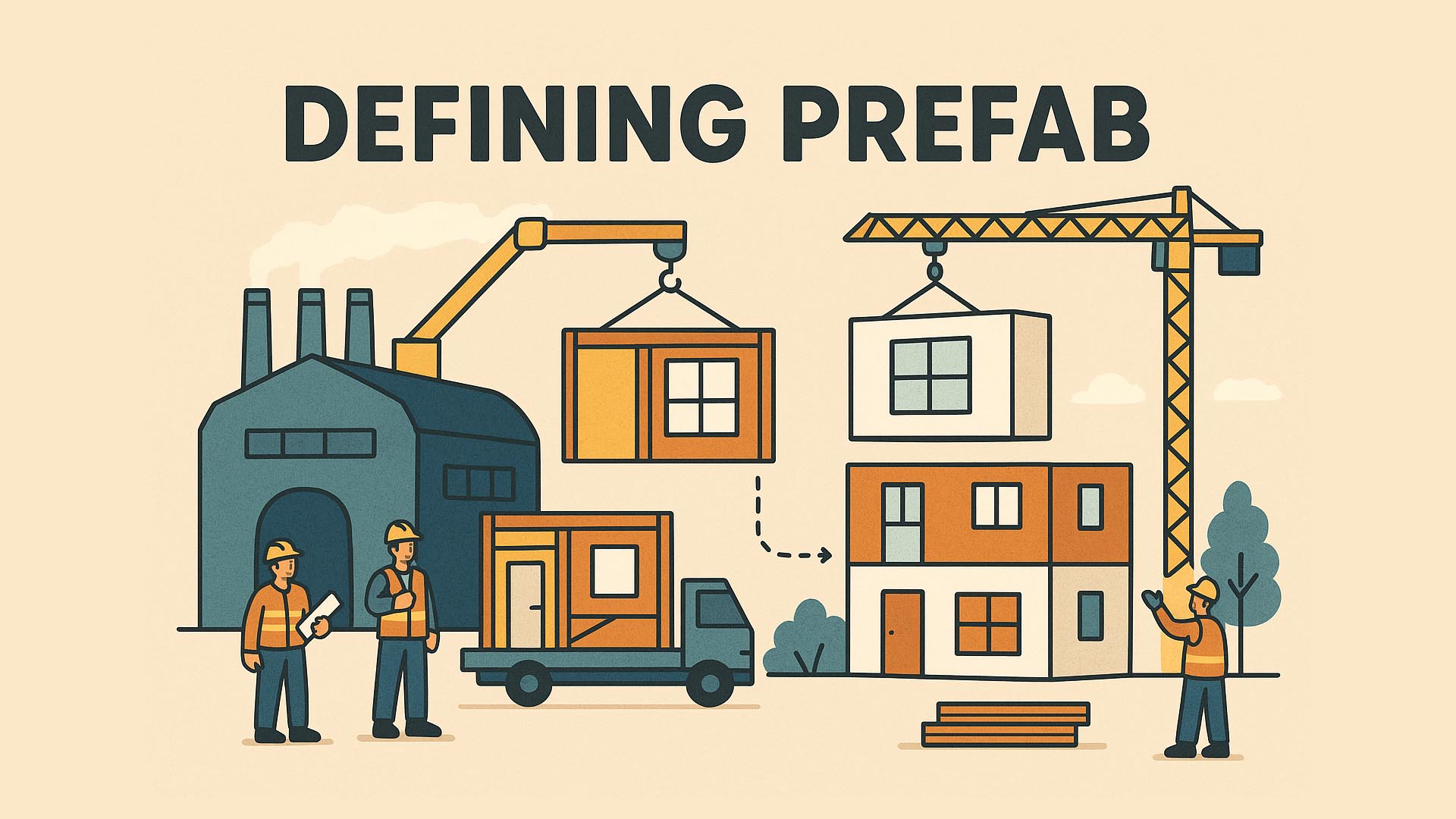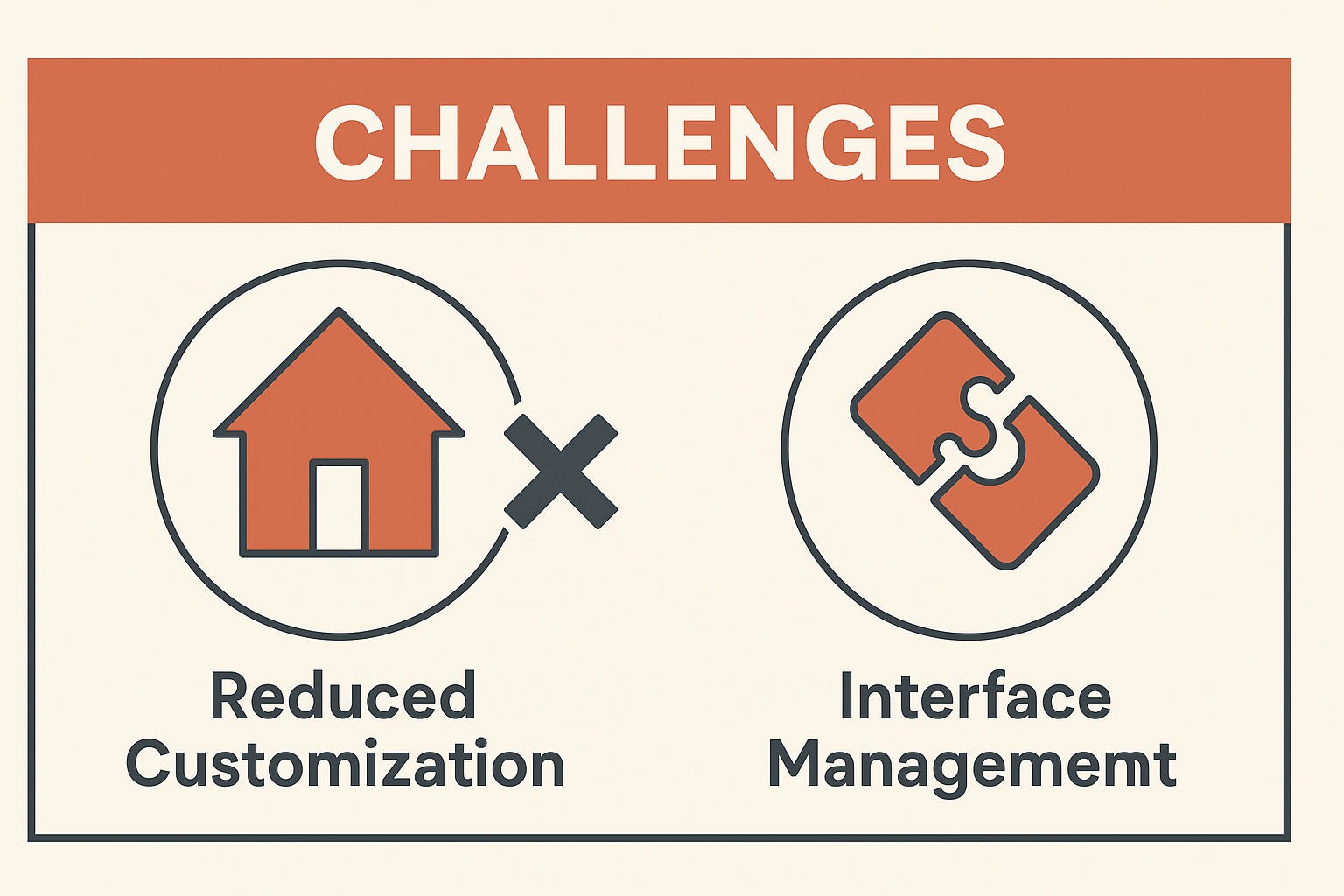

As construction continues to evolve rapidly, different methods and new terminology seem to be popping up daily. While the earliest record of a prefab building is from the 17th century, showing a panelized wood house shipped from England to Cape Ann, Massachusetts, recent technological advancements have renewed interest in prefab construction and it’s potential for sustainability and affordability.
Prefab, short for prefabricated, construction is a method referring to any kind of construction that takes place off-site, usually in a controlled environment. This involves components, panels, or sometimes entire modules being constructed in that environment, then transported to the job site for assembly. This replaces what is sometimes called “stick-building” referring to the traditional method of on-site assembly of raw materials. Buildings that are constructed using prefab methods vary widely, from kiosks, to single and temporary office units, to seasonal storefronts, apartments, hotels, and healthcare complexes.

So, how exactly does prefab construction work? The typical process in which these are built begins with a design phase, where architects and engineers create detailed drawings and digital models. This phase also includes obtaining any necessary building permits and certifying compliance with building codes.
Following this, structural components such as wall panels, floor joist systems, roof sections, and even plumbing and electrical systems are manufactured in a controlled factory environment. These materials are also often procured from the factory in which they are stored, streamlining the process.
Carefully following a logistics plan that is developed weeks in advance, prefab kits are then packaged and transported to the site. Engineers, project managers, and transport specialists will determine the best routes and timing for this to take place. They must factor in the size and weight of prefab components, the road width and bridge clearances along with traffic patterns that may cause time delays. Elements are also delivered in sequence to avoid unorderly crane hosting sequencing.
After being transported to the site, crews assemble the pre-made components to create the final structure. Cranes will lift and set the prefab pieces directly onto the prepared foundation where pieces are fastened to frames or joined with connectors depending on the type of prefab element. Minimal on-site finishes take place such as joint sealing, paint touch-ups, or exterior cladding.

Now that we’ve defined this construction method let’s jump into the various types of prefab. The first one we’ll be highlighting is panelized prefab structures. Fullerton Building Systems, a business that manufactures and installs prefabricated building shells, notes that elements of a prefab components system include a wall panelized frame with exterior siding and insulation that is constructed off-site at a factory. 2D components like wall, floor, and roof panels are fabricated off site in a controlled environment. The panels are then delivered to the assembly yard for connection into the building’s frame.
There can often be confusion between prefab construction and modular construction, as modular construction is becoming increasingly popular. However, similar to that whole conundrum of all squares being rectangles but not all rectangles being squares all modular buildings count as prefab, but not all prefab is modular. Modular construction is defined as a type of prefab construction where modules (three-dimensional sections) of a building are constructed off site.
Here’s a helpful illustration: think of a couple of Lego pieces joined together in one room, then transported and added to the rest of your creation in another room. The conjoined Lego pieces represent a module, but the act of bringing it over and connecting it to the larger piece represents the prefab method. So essentially, modular is the mode, and prefab is the method. Examples of this include apartment and hotel rooms.
A hybrid approach combines both 2D panel and 3D modular systems to create a complete structure. These methods utilize various materials, including steel, timber, and concrete to produce components for residential, commercial, and infrastructure projects. One key feature of this approach is how it uses components from both methods to form a complete structure or specific sections of it.
Steel Trusses, Joists, and Girders: Involves pre-engineered steel frames to create strong structures.
Timber Framing: Method where wood, Parallam®, glulam, and trusses make up the structural framework, ideal for eco-friendly construction. While this is most often done in residential buildings, the new CMC Science center at Claremont College in Claremont, California is an amazing example. KPRS Project Manager Brian Peterson says that the center, which opened in 2025, utilizes a heavy timber system.
Concrete Systems: Involves factory-produced concrete components, such as precast concrete panels and beams that offer durability and insulation in new industrial buildings and parking structures.
Container Buildings: Shipping containers are converted into modular spaces, allowing for a cost-effective and environmentally friendly option.

Some businesses use prefabricated construction to build single office units, multi-story office complexes, and temporary site offices. This proves to be a popular choice due to the efficiency in which spaces are assembled, with notable companies such as BOXX Modular and Mobile Modular providing prefab offices as a service. As mentioned, prefab replaces the traditional method of construction. Rather than pouring foundations and framing walls on site from scratch, these offices can be configured with open floor plans accessible to change
Prefab construction also is attractive to retailers looking to build faster speed-to-market and create branding consistency. For example, Fullerton Building Systems provides panel systems to erect walls on the shells of retail shops in less time than stick frames. Among the common buildings that are constructed using prefab include pop-up shops, kiosks, and even drive-thru windows. Phil Andersch, Marketing Head at Xtreme Cubes Las Vegas, noted that modular retail units for major QSR brands are being ordered often.
The healthcare industry makes use of prefab construction for similar reasons to the previous two. Efficiency is a must when caring for sick patients. During Covid 19 for example, many temporary hospitals and treatments centers were deployed quickly using prefab methods. Prefab modules are also used for new hospital wings, overflow spaces, or to assist existing practices in running during renovations.

Let’s look at the benefits of prefabrication construction. The first major benefit is the speed at which projects are completed. Construction teams no longer need to wait for site preparation to begin constructing the building shell and interior, as they can occur simultaneously. The buildings attempting LEED certification will find decreased waste volume by using multiple forms of prefabrication. According to B&TManufacturing, the prefab construction process is streamlined, shortening timelines.
Prefab construction is also more cost effective than traditional methods. The duplication of dimensions, shapes and materials, such as on buildings where metal stud and steel sections are repeated, results in a lower cost per square foot and a reduction of travel cost through bulk transportation. This approach also assists with cost saving as well through reduced labor needed in almost every step. In pods for hotels, the pod frame(steel base) may be an increase to the comparable cost of stick builds.
A behind-the-scenes benefit of prefab construction is how it assists with quality control. According to Autodesk, the consistency of the controlled off-site environments eliminates most of the impacts of weather on production. Simultaneously, prefab companies can conduct quality inspections from the factory and reuse the excess materials.

While prefab construction is beneficial in many ways, it is not without its challenges. One con of this method is the reduced individualism/customization in both architecture and design. To establish cost control, the system is designed to be repetitive, allowing little to no room for flexibility or customization. Although it creates brand consistency across locations, such as in pop-up shops or drive-thru’s, this simultaneously limits local customization if desired.
Another potential challenge is the interface management needed along the way. This is the process of ensuring that prefab components fit together perfectly upon assembly. Because of this, prefab construction requires meticulous planning and precision engineering of dimensions and structural connections as well as water proofing or moisture intrusion methods.
Inherent to the prefab model is a performance of shop drawing concept, and past project module details, along with submitting CD and SD designs up to 6 months prior to breaking ground. This enables your team to plan, leaving more time for hashing out details and room for customization.
While prefabricated construction is not ideal for every project, it remains a popular and effective choice for many. As new technologies emerge and the construction landscape evolves, it’s crucial to understand which methods best suit each project.